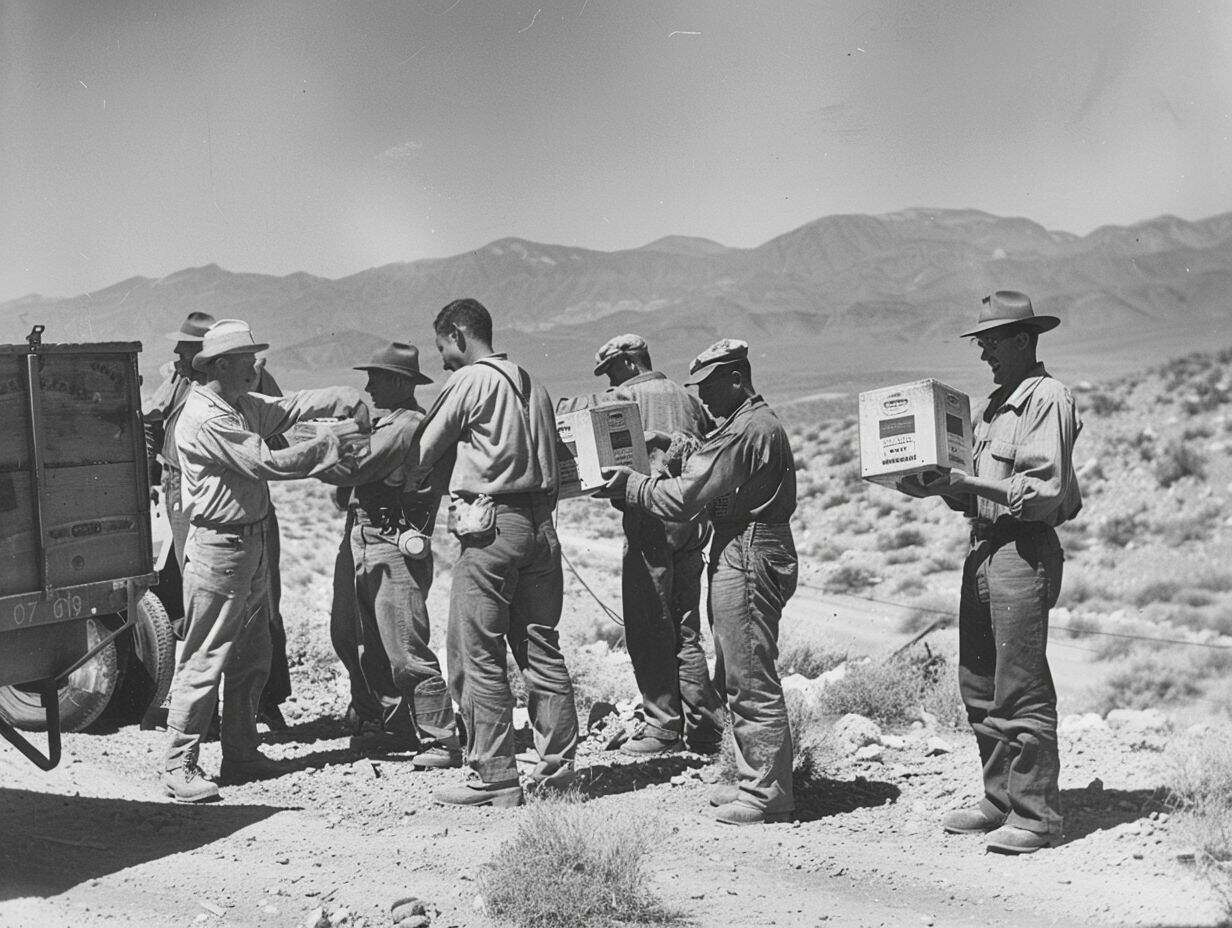In the current business landscape, many companies are opting for remote work setups to offer employees the flexibility of working from any location. However, supporting these remote workers, particularly those in remote settings, presents its unique set of challenges.
One innovative solution that has become popular is the provision of Meals Ready-to-Eat (MREs) for these workers.
This discussion delves into the significance of supporting remote workers, the advantages and obstacles of providing MREs, and how companies can ensure the safety of these meals.
Companies can also provide other forms of support to remote workers in secluded locations, such as communication tools, mental health assistance, and emergency procedures.
What is a Remote Workforce?
A Remote Workforce consists of a group of workers who work outside of a traditional office setting, often from their homes or other remote locations. These individuals use technology to stay connected and collaborate virtually in order to fulfill their job duties.
This shift from traditional office environments allows employees to select their preferred workspaces, whether that’s a comfortable home office or a peaceful coffee shop. Thanks to technological advancements, remote work has become more feasible, facilitating smooth communication and project coordination.
Even though they may be in different locations, these workers can still participate in team meetings, share documents, and take part in brainstorming sessions through video conferences and online collaboration tools. This helps foster a sense of camaraderie and productivity within the virtual workspace.
Why is Support Important for a Remote Workforce?
Support is essential for a remote workforce to ensure employee satisfaction, productivity, and team collaboration. Providing assistance and resources to remote workers can improve their virtual teamwork and overall well-being.
This supportive environment helps employees feel connected and valued, leading to increased job satisfaction and motivation. When remote workers have access to necessary resources and support systems, they are better equipped to overcome challenges and perform at their best. Fostering a culture of assistance and encouragement among remote teams can enhance communication and strengthen relationships, ultimately boosting productivity and improving teamwork.
Recognizing the importance of supporting a remote workforce, organizations can create a positive and engaging work environment that benefits both employees and the company as a whole.
What are MREs?
Meal Ready-to-Eat (MREs) are pre-packaged meals designed for consumption in environments where traditional cooking facilities may be lacking. These meals have a long shelf life and provide necessary nutrition for individuals in isolated locations.
The purpose of MREs extends beyond convenience. They offer a dependable solution for people facing challenging conditions. With a balanced combination of proteins, carbohydrates, and vitamins, these meals ensure that individuals in remote areas have access to nourishing food without sacrificing taste or quality. Their versatility allows them to be used in various scenarios, whether for military personnel, outdoor enthusiasts, or emergency preparedness. During times of crisis or extended isolation, MREs act as a valuable resource by providing a reliable source of sustenance.
How are MREs Different from Regular Meals?
MREs and regular meals differ in their packaging, shelf life, and preparation method. Unlike regular meals that require cooking or heating, MREs are ready-to-eat and intended for extended storage, emphasizing convenience and nutritional value.
MREs are packaged in durable materials that can endure harsh conditions, making them suitable for military personnel or outdoor enthusiasts. They have a longer shelf life compared to traditional meals, ensuring they remain safe to consume for extended periods.
The simplicity of preparing MREs eliminates the need for complex cooking processes, allowing individuals to enjoy a quick and easy meal on the go. In terms of nutritional content, MREs are carefully designed to provide essential nutrients, proteins, and carbohydrates, meeting the dietary requirements of individuals in challenging situations.
What are the Benefits of Providing MREs for Remote Workers?
Offering MREs for remote workers provides several advantages, such as convenience, longer shelf life, and high nutritional value. These ready-to-eat meals can improve employee satisfaction and well-being in remote work environments.
The convenience of MREs is crucial for accommodating the busy schedules of remote workers. Requiring minimal preparation, employees can easily grab a nutritious meal without disrupting their workflow. The extended shelf life of these meals ensures that remote workers always have a dependable food source, reducing the need for frequent trips to the grocery store. The high nutritional value found in each MRE serves as an important source of energy and sustenance, fostering overall health and productivity among remote employees.
1. Convenience and Portability
The convenience and portability of MREs make them ideal for individuals in remote locations or on-the-go who need quick access to meals without cooking facilities. Meal delivery services can ensure timely delivery of these ready-to-eat options.
Having access to nutritious and satisfying meals that require minimal preparation can be beneficial for individuals working remotely or on-the move. Whether in a remote cabin, off-site location, or a co-working space, having MREs available through meal delivery services can save time and effort, allowing individuals to focus on work without the need for meal preparation. These MREs are designed to be lightweight and easy to transport, making them a suitable option for those needing convenient sustenance during busy workdays.
2. Longer Shelf Life

The longer shelf life of MREs ensures that remote workers have access to non-perishable food options that can be stored for extended periods without refrigeration. These survival meals offer reliability in challenging environments.
This extended shelf life is especially crucial for workers stationed in remote locations where access to fresh food may be limited. The durability of MREs ensures that they remain viable and safe to consume even in isolated areas, making them an essential resource for individuals working in challenging terrains or under unpredictable conditions. The long shelf life of these meals reduces the need for frequent restocking, providing a convenient and efficient solution for those who require sustenance away from traditional resources.
3. Nutritional Value
The nutritional value of MREs is a significant advantage for remote workers, ensuring they receive essential nutrients and energy from these well-balanced meals. Meal Ready-to-Eat options are designed to meet the dietary requirements of employees in remote environments.
These convenient MREs are meticulously formulated to offer a balanced combination of proteins, carbohydrates, and fats, serving as a dependable source of sustenance for individuals working in isolated locations. Rich in vitamins, minerals, and fiber, MREs help sustain optimal health and meet the requirements of a physically active lifestyle. Whether operating on a remote construction site or participating in a scientific expedition, having access to nutritious and ready-to-eat meals like MREs can significantly contribute to overall well-being.
What are the Challenges of Providing MREs for Remote Workers?
While providing MREs to remote workers can be beneficial, there are challenges to consider, such as limited variety, potential food monotony, and cost implications. Overcoming these hurdles is crucial to ensuring the effectiveness of meal offerings.
To tackle the issue of limited variety, companies can regularly rotate meal choices, introducing new dishes and flavors to maintain a fresh and engaging menu. This not only helps combat food monotony but also ensures that workers anticipate their meals.
By incorporating customizable MRE options, individuals can tailor their meals to suit their tastes and preferences without significantly increasing expenses. Through careful management of MRE selection and costs, organizations can strike a balance between offering quality meals and staying within budget constraints.
1. Limited Variety and Taste
The limited variety and taste of MREs can present challenges for remote workers who may prefer a wider selection of meal options or flavors. Finding a balance between nutritional value and palatability is essential for the success of meal provision.
This equilibrium is particularly crucial for remote workers who often depend on MREs as their primary source of sustenance in isolated locations. A lack of diverse and flavorful choices can lead to monotony, resulting in decreased morale and overall satisfaction with the meals provided. In such situations, individuals may struggle to maintain their energy levels and focus throughout the day, impacting their productivity and well-being. Therefore, incorporating a range of tastes and textures into MREs is not only advantageous for health but also plays a significant role in keeping remote workers engaged and satisfied.
2. Potential for Food Boredom
The potential for food boredom with MREs arises from repetitive meal options and limited culinary experiences. Addressing this challenge requires creativity in meal planning and periodic rotation of survival meals to prevent monotony.
Introducing variety in flavors, textures, and ingredients can make a significant difference in combating food monotony. By incorporating diverse cuisines, altering cooking methods, and experimenting with different spices and seasonings, individuals can elevate their MRE dining experience. Establishing a meal schedule and planning ahead can help in organizing a well-rounded menu that keeps things interesting. Implementing these innovative meal planning techniques ensures a more enjoyable and satisfying consumption of survival meals in challenging situations.
3. Cost Considerations
Considerations regarding the cost of providing MREs for remote workers can influence budget priorities and financial feasibility. Achieving a balance between the quality and cost-effectiveness of survival meals is crucial for sustainable meal distribution strategies.
When addressing the challenges associated with the expense of MREs, it is important to find a middle ground that maintains nutritional value and taste. Remote workers depend on these meals during their demanding work schedules, underscoring the need to ensure that the provisions are both affordable and nutrient-rich. The fluctuating prices of MREs can complicate meal planning, particularly when striving to uphold a satisfying meal experience while working within a limited budget. By thoughtfully selecting cost-effective yet high-quality options, companies can effectively support their remote workforce without exceeding financial constraints.
How Can Companies Ensure the Safety of MREs for Remote Workers?

Ensuring the safety of MREs for remote workers requires companies to focus on proper storage, regular inspections, and quality control measures. Training employees on MRE safety practices is essential for maintaining high standards.
Proper storage protocols are critical in preserving the quality of MREs and ensuring that they remain safe for consumption. Storing MREs in cool, dry environments away from direct sunlight and extreme temperatures can prevent spoilage and maintain freshness. Implementing regular quality checks on the MREs not only guarantees that they meet food safety standards but also helps in identifying any potential issues early on. Employee training should cover proper handling techniques, expiration date checks, and emergency response procedures in case of any contamination concerns.
1. Proper Storage and Handling
Proper storage and handling of MREs are crucial for maintaining their safety and quality during distribution to remote workers. Companies should establish guidelines for storage conditions and handling procedures to prevent contamination. This ensures that the food within the MREs remains safe for consumption, especially in remote locations where access to fresh meals may be limited.
Adequate storage practices, such as keeping MREs in a cool, dry place away from direct sunlight and extreme temperatures, play a vital role in preserving the integrity of the food. Proper handling techniques, including utilizing gloves and following hygiene protocols, are essential to reducing the risk of cross-contamination and maintaining food safety standards for remote workers.
2. Regular Inspections and Quality Control
Regular inspections and stringent quality control checks are necessary to verify the safety and nutritional value of MREs provided to remote workers. Maintaining high standards in meal provision contributes to employee well-being.
These practices not only ensure the physical safety of workers consuming these meals but also play a crucial role in preserving the nutritional integrity of the food. By conducting regular inspections, companies can identify and rectify any potential issues promptly, safeguarding against contamination or spoilage. Quality control measures help in maintaining consistency in taste and portion sizes, thereby enhancing employee satisfaction and overall morale. Such attention to detail reflects a commitment to both the health and happiness of employees, making them feel valued and cared for in their work environment.
3. Training for Employees on MRE Safety
It is essential to provide safety training to employees on MRE handling and consumption to minimize risks and ensure proper usage. Educating remote workers on food safety practices increases their awareness and fosters a secure meal environment.
Safety training gives employees the knowledge to recognize potential hazards related to MREs, such as bacterial contamination or spoilage, and enables them to take preventive actions. Understanding proper storage methods, expiry dates, and safe handling procedures allows remote workers to significantly decrease the likelihood of foodborne illnesses or adverse reactions. This training also stresses the importance of following manufacturer instructions precisely to ensure optimal consumption and reduce any potential health risks.
What Other Support Can Companies Provide for Remote Workers in Isolated Locations?
Companies may provide various support services for remote workers in isolated locations, in addition to meal provision. Essential offerings include communication tools, mental health support, and emergency protocols to ensure employee well-being and engagement.
Communication tools are vital for promoting seamless interaction among remote teams. These tools can include video conferencing platforms, instant messaging services, and project management tools to keep everyone connected. Mental health support services, such as virtual counseling sessions, mindfulness training, and stress management resources, can also aid employees in navigating the challenges of remote work. Furthermore, establishing clear emergency procedures, which include contact information for assistance and guidelines for handling unforeseen situations, can enhance the sense of security and preparedness for remote workers.
1. Communication Tools
Equipping remote workers with effective communication tools enhances collaboration and connectivity within virtual teams. Providing support services that enable seamless interactions and information sharing fosters a cohesive remote work environment.
These tools play a crucial role in bridging the physical gap between team members located in different parts of the world, ensuring that communication flows smoothly and projects progress efficiently. The ability to conduct virtual meetings, share documents in real-time, and engage in instant messaging helps remote workers feel connected and engaged with their colleagues, despite not being in the same physical space. These communication tools promote transparency, accountability, and productivity, ultimately leading to successful outcomes for virtual teams working remotely.
2. Mental Health Support

Providing mental health support for remote workers is essential to address feelings of isolation and stress that may arise in isolated locations. Employee care initiatives that promote well-being and offer resources for mental health assistance contribute to a positive work environment.
Encouraging employees to prioritize self-care and take regular breaks can help combat feelings of isolation while working remotely. Implementing virtual social activities and team-building exercises can foster a sense of community and connection among remote teams. Offering access to confidential counseling services and mental health resources can provide remote workers with the support they need to navigate challenges and maintain their well-being.
By prioritizing isolation support and mental health resources in employee care programs, organizations can demonstrate their commitment to the holistic health and happiness of their remote workforce.
3. Emergency Protocols
Establishing clear emergency protocols for remote workers is crucial to ensuring their safety and well-being in isolated locations. Remote support mechanisms that offer immediate assistance during critical situations are essential for upholding workplace safety standards.
When remote workers are stationed in distant or isolated areas, the importance of effective emergency procedures cannot be emphasized enough. Having well-defined protocols in place during crises allows for prompt and efficient responses, potentially preventing serious consequences. The role of remote support in quickly addressing emergencies not only improves overall workplace well-being but also fosters a sense of security among remote employees. Implementing proactive safety measures helps to mitigate risks and enhances the resilience and preparedness of remote workers when faced with unforeseen events.
Frequently Asked Questions
What is a remote workforce and why is it important to provide them with MREs?
A remote workforce consists of employees who work from a location that is not the main office or their home. These workers may be situated in isolated locations where access to food and resources is limited. Providing MREs (Meals Ready to Eat) ensures that these workers have access to nutritious meals while working in these isolated locations.
What are MREs and how are they different from regular meals?
MREs (Meals Ready to Eat) are pre-packaged meals that are commonly used by the military for their convenience, long shelf life, and nutritional value. They are different from regular meals as they do not require any additional preparation or cooking and can be eaten straight from the package.
What are the benefits of providing MREs to a remote workforce?
Providing MREs to a remote workforce ensures that they have access to nutritious meals even in isolated locations. This can boost their productivity and morale, as they do not have to worry about finding food or going hungry while working. Additionally, MREs have a long shelf life and do not require refrigeration, making them a convenient and practical option for remote workers.
How do you ensure that MREs are safe and of good quality for consumption?
MREs go through extensive testing and quality control processes before they are distributed to consumers. The manufacturers of MREs must adhere to strict regulations set by the government to ensure the safety and quality of the meals. Additionally, MREs have a recommended shelf life and expiration date, so it is important to check the dates before distributing them to remote workers.
What options are available for providing MREs to a remote workforce?
There are various options for providing MREs to a remote workforce. Companies can purchase pre-packaged MREs from manufacturers or choose to assemble their own MREs with specific items and meals. Another option is to partner with a meal delivery service that specializes in providing MREs to remote locations.
How can companies ensure that remote workers have access to a variety of MRE options?
To ensure a variety of MRE options, companies can choose to work with suppliers that offer a wide range of choices for meals and snacks. They can also rotate the MREs distributed to remote workers to prevent them from getting bored with the same meals. Another option is to provide MREs with different dietary options to accommodate for any specific dietary restrictions or preferences of workers.


